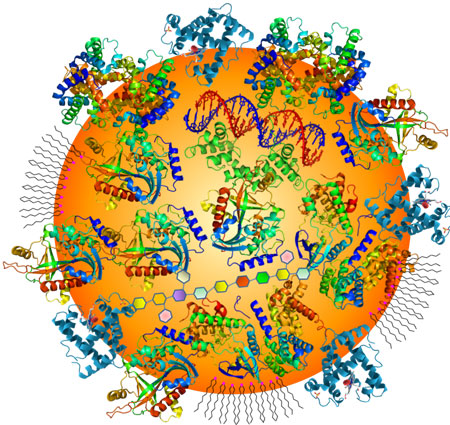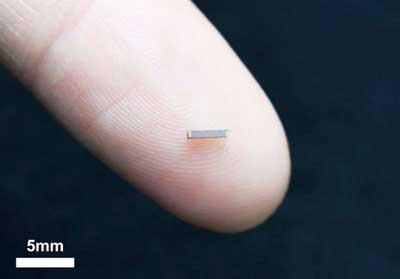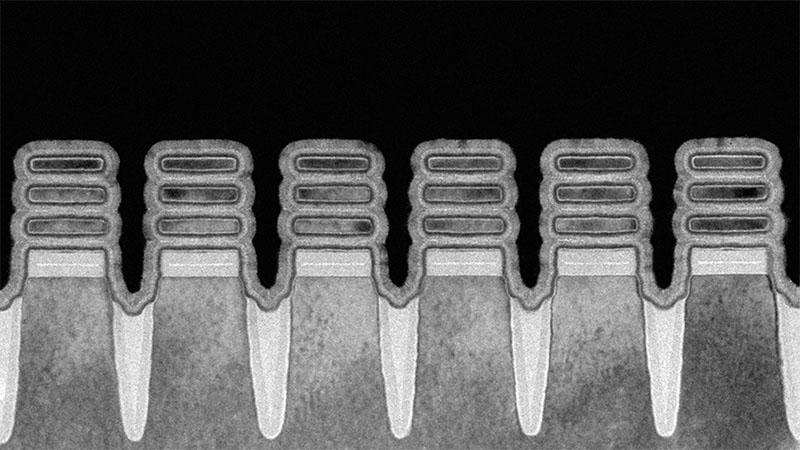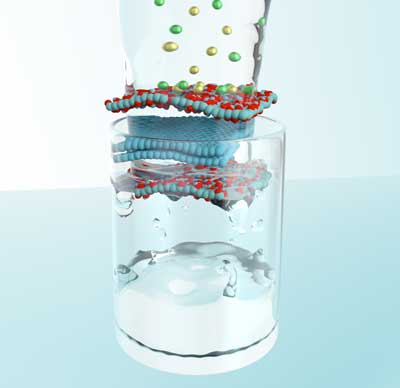10 Key areas where nanotechnology already impacts our lives
|
|
Nanotechnology is a rapidly growing field with the potential to revolutionize many industries and aspects of daily life. By manipulating matter at the nanoscale (one nanometer is one billionth of a meter), researchers are able to create new materials and devices with unique properties that can be used for a variety of new materials and applications.
|
|
There is almost no field today where nanotechnology isn't applied in some form or shape as things like surface coatings, sensors, electronic components, membranes, etc. – in medicine, environmental remediation, water filtration, nanoelectronics, food and agriculture, cosmetics, energy and batteries, space and aeronautics, automotive industries, displays, sports equipment and many more.
|
|
A prime nanotechnology example of an industry where nanoscale manufacturing technologies are employed on a large scale and throughout is the semiconductor industry where device structures have reached the single nanometers scale. Your smartphone, smartwatch or tablet all are containing billions of transistors on a computer chip the size of a finger nail.
|
|
Let's take a look at the 10 most promising areas where nanotechnologies already are having an impact:
|
1. Nanotechnology in medicine improves diagnosis and treatment
|
|
Nanotechnology has the potential to revolutionize the field of medicine by enabling the development of new diagnostic tools and therapies that operate at the nanoscale. For instance, a quick and simple blood test to detect early-stage cancer relies on the discovery of cancer biomarker molecules from the 'protein corona' formed on the gold nanoparticles upon adsorption of blood serum proteins to the nanoparticle surface.
|
 |
| Illustration of a protein corona formed on a gold nanoparticle (AuNP) surface upon adsorption of blood serum proteins and other biomolecules. (Image: Dr. Huo, University of Central Florida)
|
|
In therapy, nanotechnology to kill cancer cells is at the forefront of both targeted drug delivery and intrinsic therapies. For instance, nanoparticles can be used as tumor-destroying hyperthermia agents that are injected into the tumor and then be activated to produce heat and destroy cancer cells locally either by magnetic fields, X-Rays or light.
|
|
By using nanoparticles to deliver drugs directly to cancer cells, the effectiveness of treatment can be improved and the side effects of chemotherapy reduced.
|
|
Nanotechnology is also being used to develop new imaging techniques, such as nanoparticle-based contrast agents for MRI scans, that can provide more detailed and accurate information about the body's tissues and organs.
|
|
Additionally, nanotechnology is being used to develop new materials for use in medical devices, such as implantable sensors and artificial joints, which can improve patient outcomes.
|
|
Read more in our in-depth article on nanomedicine.
|
2. Nanotechnology in energy production increases efficiency and sustainability
|
|
Nanotechnology has the potential to revolutionize the energy industry by increasing the efficiency of energy production and storage. For example, nanomaterials can be used to create more efficient solar cells, which can capture more sunlight and convert it into electricity.
|
|
Nanoparticles are also being used to create more efficient batteries for storing renewable energy, such as those used in electric vehicles. Additionally, nanotechnology is being used to create new catalyst materials for use in fuel cells, which can convert chemical energy into electricity with high efficiency.
|
|
By increasing the efficiency of energy production and storage, nanotechnology has the potential to help reduce our reliance on fossil fuels and mitigate the negative impacts of climate change.
|
|
Nanotechnology is being used to create new, lightweight and high-capacity batteries and supercapacitors that can store energy more efficiently and enable the use of renewable energy sources on a larger scale.
|
 |
| A micro supercapacitor on the tip of a person's finger. (Image: UNIST)
|
|
Working on the nanoscale, researchers have shown that an inexpensive and environmentally benign inorganic light harvesting nanocrystal array can be combined with a low-cost electrocatalyst that contains abundant elements to fabricate an inexpensive and stable system for photoelectrochemical hydrogen production.
|
|
Read more in our in-depth article on nanotechnology in energy.
|
3. Nanotechnology in environmental remediation is cleaning up pollution on a small scale
|
|
Nanotechnology is being used in a variety of ways to help clean up and protect the environment. For example, nanoparticles are being developed to help remove contaminants from soil and water, such as oil spills, radioactive contaminants, and heavy metals. Nanoparticles can also be used to create more efficient catalysts for chemical reactions, which can help to reduce the emission of harmful gases.
|
|
Nanotechnology could make battery recycling economically attractive.
|
|
Additionally, nanomaterials are being developed for use in air filtration systems, which can help to remove pollutants from the air we breathe. Also membrane systems for carbon dioxide capture.
|
|
By using nanotechnology to remediate environmental damage and protect the natural world, we can help to create a healthier planet for future generations. Read more in our in-depth article on nanotechnology in environmental applications.
|
|
Additionally, nanotechnology is being used to create new sensors and monitoring systems that can detect and measure the presence of contaminants in the environment at very low levels.
|
4. Nanotechnology in agriculture and food science enhances nutrition and food safety
|
|
Nanotechnology is being used to improve the safety and quality of the food we eat, as well as to increase the efficiency of agricultural practices. For example, nanoparticles are being developed for use in food packaging to help extend the shelf life of products and prevent spoilage.
|
|
Nanotechnology is being used to develop new food products and ingredients that are more nutritious and safer to consume. For example, researchers are using nanotechnology to create new food additives that can improve the taste, texture, and shelf life of foods. Nanoparticles are also being used to create new materials for use in agricultural equipment, such as more efficient irrigation systems and precision farming tools.
|
|
Additionally, nanotechnology is being used to develop new methods for detecting and preventing foodborne illness, such as the use of nanoparticles to detect pathogens in food. By using nanotechnology to improve food safety and agriculture, we can help to ensure that people around the world have access to healthy, nourishing food.
|
|
Read more in our in-depth article on nanotechnology in food and agriculture.
|
5. Nanotechnology in electronics drives miniaturization and performance improvements
|
|
Nanotechnology is being used to create new materials and devices that can enable the miniaturization of electronics, as well as to improve their performance. For example, researchers are using nanotechnology to create new semiconductor materials that can be used to make smaller and faster transistors for use in computer processors and other electronic devices. Additionally, nanotechnology is being used to create new nanosensors and other devices that can operate at the nanoscale and enable new capabilities in electronics.
|
 |
| Row of six 2 nm transistors, each with four gates, as seen using transmission electron microscopy. 2 nm is no larger than the width of a single strand of human DNA. (Image: IBM)
|
|
The term nanoelectronics covers a diverse set of devices and materials, with the common characteristic that they are so small that physical effects alter the materials' properties on a nanoscale – inter-atomic interactions and quantum mechanical properties play a significant role in the workings of these devices.
|
6. Nanotechnology in construction leads to stronger and more durable materials
|
|
Nanotechnology is being used to develop new materials that are stronger and more durable than existing ones, with applications in the construction industry. For example, researchers are using nanotechnology to create new, nanostructured concrete materials that are more resistant to cracking and other forms of damage, as well as to develop new coatings and treatments that can improve the durability and longevity of buildings and other structures. Nanoengineering of cement-based materials can result in outstanding or smart properties. Furthermore, the introduction of nanotechnology in the cement industry has the potential to address some of the challenges such as CO2 emissions, poor crack resistance, long curing time, low tensile strength, high water absorption, low ductility and many other mechanical performances.
|
|
Several applications have been developed for this specific sector to improve the durability and enhanced performance of construction components, energy efficiency and safety of the buildings, facilitating the ease of maintenance and to provide increased living comfort.
|
7. Nanotechnology in water filtration is removing contaminants at the nanoscale
|
|
Nanofiltration is a type of membrane filtration process that is used to separate molecules based on size. It is one of the four membrane technologies that utilize pressure to effect separation of contaminants from water streams but it is more selective in the types of molecules it can filter out. The other three are microfiltration, ultrafiltration and reverse osmosis (RO).
|
|
All of these technologies utilize semi-permeable membranes that have the ability to reject dissolved and/or suspended solids from a water stream containing these contaminants. As a result, nanofiltration is often used in a variety of applications, including water treatment, food and beverage processing, and the pharmaceutical industry.
|
 |
| Illustration of a graphene-based membrane for producing clean water. (Image: Aaron Morelos-Gomez)
|
|
Read more in our in-depth article on nanotechnology in filtration applications.
|
8. Nanotechnology in clothing and textiles improves comfort and performance
|
|
The impact of technology on the textile industry is no longer limited to the design and production environment of clothing. Now, technology is becoming part of the textile itself (read more in our in-depth article on smart clothing and smart textiles).
|
|
The future of your shirts, socks and gloves will be electronic. In years to come, wearable electronics will look nothing like even your smallest electronic gadget today. Not only will such devices be embedded on textile substrates, but an electronics device or system could become the fabric itself (see for instance: Nanotechnology e-textiles for bio-monitoring and wearable electronics). These e-textiles will have the revolutionary ability to sense, act, store, emit, and move – think biomedical monitoring functions or new man-machine interfaces, not to mention game controllers – while leveraging an existing low-cost textile manufacturing infrastructure.
|
|
For example, researchers are using nanotechnology to develop new fabric treatments that can make clothing more water-resistant, stain-resistant, and wrinkle-resistant, as well as to create new fabrics that can regulate body temperature and moisture to keep wearers more comfortable. Nanoparticles are also being used to create fabrics that have improved thermal insulation, UV protection, and antimicrobial properties. By using nanotechnology to create advanced fabrics, the textile industry can produce clothing and other products that are more comfortable, functional, and sustainable.
|
|
As a result, nanoengineered functional textiles are going to revolutionize the clothing that you'll wear. The potential of nanotechnology in the development of new materials in the textile industry is considerable. On the one hand, existing functionality can be improved using nanotechnology and on the other, it could make possible the manufacture of textiles with entirely new properties or the combination of different functions in one textile material (for more on this, read our Nanowerk Spotlight on this topic: "Nanotechnology textiles").
|
9. Nanotechnology in defense and security protects people and infrastructure and improves threat detection
|
|
Nanotechnology is being applied in a variety of ways to enhance defense and security. The rapid emergence and confluence of nanotechnologies, biotechnologies and information technologies in the past two decades is having a huge impact on the development of military technologies. Some examples: Nanotechnology-enabled high strength, light weight, corrosion and heat resistant structural materials (metals, alloys, ceramics, polymers, composites); thin-films made of nanocarbons that can be deposited onto surfaces for electrically active coatings; nanocomposites and engineered nanoparticles for high-energy munitions; nanostructured metals and energy-absorbing nanomaterials for armaments; self Decontaminating Surfaces exploiting surface structures of nanomaterials; and 'smart' equipment including protective clothing, armors and ammunition; improved low observability (camouflage); sensing and mitigation of threats from landmines and chemical, biological, radiological and nuclear (CBRN) warfare agents.
|
|
For more on this, read our Nanowerk Spotlight on this topic: "How nanotechnologies are shaping the future of warfare".
|
10. Nanotechnology in space exploration enables new capabilities and discoveries
|
|
Nanotechnology is being used to enable new capabilities and make new discoveries in space exploration in the areas of propulsion systems, radiation shielding, anti-satellite weapon countermeasures, space instrumentation, and potential space elevator design. For example, researchers are using nanotechnology to develop new materials and technologies that can withstand the harsh conditions of space, such as extreme temperatures, radiation, and vacuum. These materials and technologies can be used to create stronger, lighter, and more durable spacecraft and other space systems.
|
|
Read more in our in-depth article on nanotechnology in space.
|




